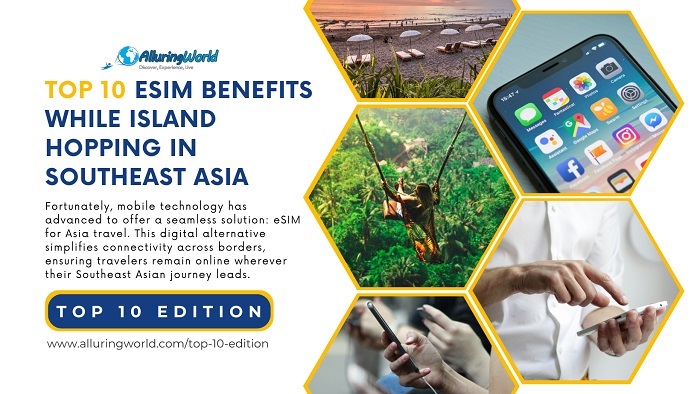The vibrant archipelagos of Southeast Asia, from the pristine beaches of Bali to the stunning shores of Boracay, have long captured the imagination of travelers. Yet, while hopping between these idyllic islands like Phuket and Palawan, a common challenge arises: staying connected. Navigating different physical SIM cards, battling high roaming fees, and enduring unreliable Wi-Fi can quickly turn paradise into frustration. Fortunately, mobile technology has advanced to offer a seamless solution: eSIM for Asia travel. This digital alternative simplifies connectivity across borders, ensuring travelers remain online wherever their Southeast Asian journey leads, transforming the traditional connectivity puzzle into a streamlined experience.
An eSIM (embedded SIM) is a digital version of a physical SIM card, integrated directly into a smartphone or tablet. Instead of purchasing and inserting new SIM cards for each country, users can remotely activate mobile data plans directly through apps or provider websites. This allows for instant plan switching without the need for any physical components.
Many newer smartphones, including recent models from Apple, Samsung, and Google, support eSIM functionality, making the technology increasingly accessible for international travelers.
1. Seamless Border Crossings:
With a single eSIM plan covering multiple countries, travelers can effortlessly transition from Bali’s beaches to Manila’s vibrant cityscape without the hassle of swapping SIMs or losing service. This is particularly invaluable for multi-country itineraries.
2. Cost-Effective Data Plans:
Traditional international roaming fees can be prohibitively expensive. eSIM providers offer competitively priced regional plans that encompass several Southeast Asian nations under one subscription, leading to significant cost savings.
3. Instant Activation and Flexibility:
Unlike physical SIMs that require finding a vendor and waiting for activation, eSIM plans can be purchased and activated before departure. Travelers land with their data already active, bypassing time-consuming airport SIM kiosks, so please evaluate how much data you realistically need based on your activities. Streaming video, video calls, and frequent social media sharing require more robust plans, while light browsing and navigation need less data.
4. Avoiding Local Network Pitfalls:
While local SIM cards can sometimes offer cheaper rates, they often come with limitations such as language barriers during setup, short validity periods, or inconsistent coverage across islands. Reputable eSIM providers partner with top local carriers to ensure strong, reliable signals.
5. Essential for Remote Destinations:
Many islands feature remote beaches, national parks, or boat rides where mobile data is crucial. Whether for navigation in Bali’s Nusa Penida, translation in rural Palawan, or ride-hailing in Phuket, an eSIM ensures you’re always connected when Wi-Fi is scarce, however, not all eSIM providers offer comprehensive coverage. Verify that your chosen provider includes all planned destinations and offers partnerships with multiple local carriers for stronger signals
6. Reliable Coverage in Popular Hotspots:
Even in popular destinations like Boracay or Langkawi, certain beach areas and coastal zones can have inconsistent Wi-Fi, especially during peak seasons. An eSIM provides a dependable connection where local Wi-Fi might falter.
7. Supports Modern Travel Needs:
In an age of digital nomadism and remote work, seamless global connectivity is an expectation. An eSIM meets this demand, allowing travelers to manage logistics, share moments, and access essential services on the go. Additionally, a reliable eSIM provider offers 24/7 customer service with clear troubleshooting resources, which can be crucial if any activation issues arise during your journey.
8. Streamlined by Regional Cooperation:
The Association of Southeast Asian Nations (ASEAN) recognizes the importance of digital infrastructure for tourism. This growing cooperation helps eSIM providers secure agreements for cross-border data access without costly roaming penalties.
9. Empowers Planning and Navigation:
Reliable data is critical for arranging excursions, booking transportation, and navigating bustling streets in cities like Phuket or exploring remote lagoons in Palawan. An eSIM ensures you have the tools you need for a smooth trip, whereas some eSIM plans offer flexible validity windows, allowing activation to coincide with your travel dates. Look for providers offering customizable start dates and plan extensions.
10. Future-Proof Connectivity:
Governments across Southeast Asia, like the Philippine Department of Information and Communications Technology, are actively improving nationwide connectivity. Choosing an eSIM aligns with this digital progression, making your travel experience increasingly seamless and convenient.
The growing popularity of eSIM technology reflects a broader shift toward borderless travel convenience. As digital nomadism expands and remote work culture becomes mainstream, seamless global connectivity is no longer a luxury but an expectation.
Governments in Southeast Asia have acknowledged this trend, with several tourism boards promoting digital accessibility as part of their national development goals. For example, the Philippine Department of Information and Communications Technology continues to prioritize improved nationwide connectivity, making the region increasingly attractive to tech-savvy visitors.
Island-hopping through Southeast Asia delivers some of the world’s most breathtaking landscapes, diverse cultures, and unforgettable adventures. Yet in this digital age, even the most idyllic setting can feel incomplete without reliable connectivity. By choosing the right eSIM for Asia travel, modern explorers can eliminate logistical headaches, reduce costs, and focus entirely on the journey itself. From the emerald cliffs of Palawan to the turquoise bays of Bali, one simple digital plan ensures that your connection to adventure is never interrupted.

